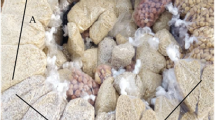Abstract
In this study, the contamination levels of total aerobic plate counts, Escherichia coli and various pathogenic bacteria in ready-to-eat (RTE) foods were investigated in Korea. A total of 634 samples were purchased randomly from 47 stores located in 3 different provinces. The aerobic plate count levels of RTE occurred in a relatively wide range, of 1.0–7.9 log CFU/g. E. coli and Listeria monocytogenes were detected in only 2 samples in the qualitative test. Staphylococcus aureus and Bacillus cereus were detected in 12.3 and 12.6% of the samples at levels up to 1 log CFU/g. These results demonstrate that RTE foods in Korea can be contaminated by a variety of pathogenic bacteria. Therefore, precautionary measures are necessary for consumer protection, including the improvement of sanitary conditions in the processing plants and sales locations for RTE products in Korea.
Similar content being viewed by others
References
Meldrum RJ, Smith RMM, Ellis P, Garside J. Microbiological quality of randomly selected ready-to-eat foods sampled between 2003 and 2005 in Wales, UK. Int. J. Food Microbiol. 108: 397–400 (2006)
Nguz K. Assessing food safety system in sub-Saharan countries: An over view of key issues. Food Control 18: 131–134 (2007)
Varnam AH, Evans MG. Foodborne Pathogens: Illustrated Text. 1st ed. Mosby Elsevier Health Science, St. Louis, MO, USA (1991)
Abdelgadir AM, Srivastava KK, Gopal RP. Detection of Listeria monocytogenes in ready-to-eat meat products. Am. J. Anim. Vet. Sci. 4: 101–107 (2009)
Kanko KI, Hayashidani H, Ohtono Y, Kosuge J, Karo M, Takahashi K. Bacterial contamination of ready-to-eat foods and fresh products in retail shops and food factories. J. Food Protect. 62: 622–649 (1996)
Ganguli A, Bansal S, Malik N, Rana AK, Ghosh M. Microbiological quality and safety of two popularly consumed raw, street vended foods in India. Food Sci. Biotechnol. 13: 417–420 (2004)
Bean NH, Grifin PM, Goulding JS, Ivey CB. Food-borne disease outbreaks, a five year summary 1993–1987. J. Food Protect. 53: 711–728 (1990)
Ismail SA. Microbiological quality of hawawshy consumed in Ismailia, Egypt. J. Food Safety 26: 251–263 (2006)
Park SY, Choi JW, Yeon JH, Lee DH, Kim KS, Park KH, Ha SD. Assessment contamination levels of foodborne pathogens isolated in major RTF foods marketed inn convenience stores. Korean J. Food Sci. Technol. 37: 274–278 (2005)
Christison CA, Linsay D, Holyvon A. Microbiological survey of ready-to-eat foods and associated preparation surfaces in retail delicatessens, Johannesburg, South Africa. Food Control 19: 727–733 (2008)
Gibbons IS, Adesiyun A, Seepersadsingh N, Rahaman S. Investigation for possible source(s) of contamination of ready-to-eat meat products with Listeria spp. and other pathogens in a meat processing plant in Trinidad. Food Microbiol. 23: 359–366 (2006)
Angelidis AS, Chronis EN, Papageorgiou DK, Kazakis II, Arsenoglou KC, Stathopoulos GA. Non-lactic acid contaminating flora in ready-to-eat foods: A potential food-quality index. Food Microbiol. 23: 95–100 (2006)
Beuchat LR, Ryu JH. Produce handling and processing practices. Emerg. Infect. Dis. 3: 459–465 (1997)
KFDA. Food Code. Korea Food & Drug Administration, Seoul Korea (2008)
Steel RGD, Torrie JH. Principles and Procedure Statistics with Special Reference to the Biological Sciences. McGraw-Hill, New York, NY, USA. pp. 107–109 (1960)
Banwart GJ. Control microorganisms. p. 532. In: Basic Food Microbiology. Banwart GJ (ed). AVI Book, New York, NY, USA (1989)
Park SY, Choi JW, Yeon JH, Lee MJ, Oh DH, Hong CH, Baek GJ, Woo GJ, Park JS, Ha SD. Assessment of contamination level of food borne pathogens in the main ingredients of kimbab during the preparing process. Korean J. Food Sci. Technol. 37: 122–128 (2005)
Levine MM. Escherichia coli that cause diarrhea: Enterotoxigenic, enteropathogenic, enteroinvasive, enterohemorrhagic, and enteroadherent. J. Infect. Dis. 155: 377–389 (1987)
Kang YS, Yoon SK, Jwa SH, Lee DH, Woo GJ, Park YS, Kim CM. Prevalence of Staphylococcus aureus in kimbab. Korean J. Food Hyg. Saf. 17: 31–35 (2002)
Little CL, Taylor FC, Sagoo SK, Gillespie IA, Grant K, Mclauchlin J. Prevalence and level of Listeria monocytogenes and other Listeria species in retail pre-packaged mixed vegetable salads in the UK. Food Microbiol. 24: 711–717 (2007)
Wagner M, Auer B, Trittemmel C, Hein I, Schoder D. Survey on the Listeria contamination of ready-to-eat food products and household environments on Vienna, Austria. Zoonoses Public Hlth. 54: 16–22 (2007)
European Commision 2000. Opinion of the Scientific Committee on Veterinary Measures Relating to Public Health on Listeria monocytogenes, 23 September 1999. Available at http://europa.eu.int/comm/food/fs/sc/scv/out25-en.pdf. Assessed Mar. 21, 2006.
Craven PC, Mackel DC, Baine WB, Barker WH, Gangarosa EJ. International outbreak of Salmonella eastbourne infection traced to contaminated chocolate. Lancet 1: 788–792 (1975)
Glynn JR, Palmer SR. Incubation period, severity of diseases, and infecting dose: Evidence from a Salmonella outbreak. Am. J. Epidemiol. 136: 1369–1377 (1992)
Chung MS, Kim CM, Ha SD. Detection and enumeration of microorganism in ready to eat foods, ready to cook foods, and fresh cut produce in Korea. J. Food Saf. 30: 480–489 (2010)
Author information
Authors and Affiliations
Corresponding author
Rights and permissions
About this article
Cite this article
Cho, J.I., Lee, S.H., Lim, J.S. et al. Detection and distribution of food-borne bacteria in ready-to-eat foods in Korea. Food Sci Biotechnol 20, 525–529 (2011). https://doi.org/10.1007/s10068-011-0073-y
Received:
Revised:
Accepted:
Published:
Issue Date:
DOI: https://doi.org/10.1007/s10068-011-0073-y



